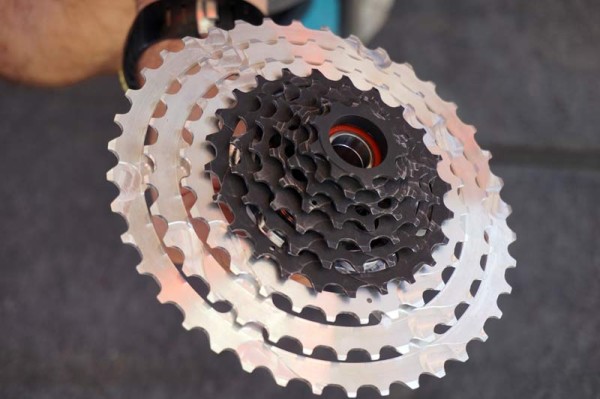e*thirteen had a plethora of prototypes on hand, only showing off things that are at least a few months out. The most interesting was this prototype EXF Cassette, which will offer a wide range set of cogs that runs from a 9-tooth up to 42-tooth in both 10 and 11 speed options. Following that will be an 8-speed version for DH, but that one’s still in testing with the Polygon/UR Team.
Weights should be in between XX1 and XTR, but it should come in much cheaper. Final MSRP is TBD. The lower cluster is steel, made in two pieces that are bolted together.
The upper 3-tooth cluster is aluminum and slides onto the freehub body portion of an XD Driver with a lock ring that holds that piece in place to attach the cassette to the wheel. Then the lower cluster slots into the upper section and a chain whip is used to twist and lock it into place. Wanna see the back side?
Hooked flanges on the lower cluster slot into the grooves on the big one, then are twisted into the grooves to lock it into place. They’ve been working on it for quite a while and are continuing the mechanical and real-world testing to ensure it remains solidly together.
Final production colors are likely to change.
UPDATE: at e*thirteen’s request, some of the internal photos were removed due to IP concerns.
The threads that a normal XX1 cassette screw onto are at the back of the XD Driver body, and e*thirteen uses those to place a lock ring up against the upper three cogs. Then add on the little piece and it all adds up to a massive 467% range.
They did mention that this isn’t meant for road applications where you might be spinning the 9-tooth at high speeds because the chain can want to lift off. But for mountain biking, the speed isn’t high enough to cause issues. And, let’s face it, we don’t spend much time in the smallest cog anyway.
The LG1r and TRSr Trail are their first carbon cranks, and both use the same arm with different spindles to suit the intended use their model names imply. The LG1r has a 83mm spindle for DH bikes and the TRS has a 73mm spindle for standard mountain bikes, which will work with 68mm frames by adding spacers.
Weight should be between a Race Face Next SL and SixC, but tough enough for DH use. The spindle and outside facing bolts will all be black, too.
They get a new alloy APS preload knob, which pushes the center section out to take up any slack while remaining fully sealed to keep mud out from between it and the crankarms.
The direct mount narrow wide chainrings are a new forged, machined piece that will replace the current Guidering M. Still in testing on all of this stuff, both on the trail and in machine testing, so they’re looking at late fall on the cranks and cassette.
The carbon arms are very thick, suggesting massive stiffness.
The upcoming LG1r chain guide will get a carbon backplate option that’ll save a bit of weight. Actual weight and pricing is TBD.
The ISCG shims will come with all chain guides starting in June. They come in 1mm and 2mm and replace all the litte random washers some folks are using to space the guides away from the frame.








